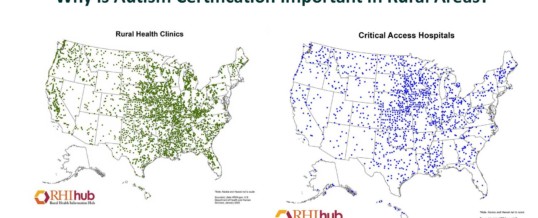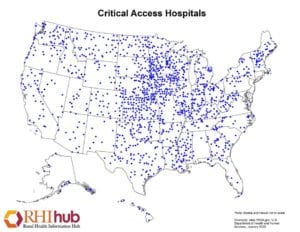
Critical Access Hospitals (CAHs) and Rural Health Clinics (RHCs) play a significant role in providing primary and preventative care in rural areas that are underserved. Currently, there are 4,500 RHCs and 1,350 CAHs nationwide.
It is critical that these facilities are able to provide services for people on the autism spectrum, as this is a huge area of need in this country.
“In addition to a diminished presence of and access to minimally adequate care for rural areas, there is a lack of evidence-based practices for identifying and providing services for individuals with ASD (Rhoades et al., 2007). This combination of factors contributes to a variety of unfavorable outcomes for affected children who live in rural locations, such as delays in developmental screening and diagnosis as well as fewer available interventions, which can lead to comparatively worse educational and functional outcomes.”- Rural Trends in Diagnosis and Services for Autism Spectrum Disorder, NCBI
Undiagnosed autism can often manifest itself as behavioral problems, especially when that individual has had no therapy of any kind. The recommendations for better treating someone with autism also directly help staff to prevent panic attacks as well as be helpful for many other people with a range of sensory and cognitive disorders.
Why Autism Certification is Important for Critical Access Hospitals (CAHs)
Only 1% of emergency departments getting training in autism, it is a safe bet that most Critical Access Hospitals (CAHs) do not have training in this area. The populations they serve face similar underserved populations as Rural Health Clinics (RHCs) for diagnosis and effective treatment due to their rural nature.
With people on the autism spectrum visiting emergency departments 4-10x as often as neurotypical people, it is not a matter of if people with autism will come in but how many. In rural populations, there is more of a problem of missed diagnosis, so there will be many people who will not disclose that they have autism (as they won’t know) but where training will help staff to be able to recognize and approach these people differently to make their visit more effective.
What a CAH is and Why it Matters
 Critical Access Hospitals or CAHs are eligible rural hospitals that were given their designation by the Centers for Medicare and Medicaid Services (CMS). CAHs were designed with the goal to decrease the financial vulnerability of rural hospitals and make healthcare accessible to those in rural communities.
Critical Access Hospitals or CAHs are eligible rural hospitals that were given their designation by the Centers for Medicare and Medicaid Services (CMS). CAHs were designed with the goal to decrease the financial vulnerability of rural hospitals and make healthcare accessible to those in rural communities.
To qualify as a CAH, the following requirements must be met:
- “Have 25 or fewer acute care inpatient beds”
- “Be located more than 35 miles from another hospital”
- “Maintain an annual average length of stay of 96 hours or less for acute care patients”
- “Provide 24/7 emergency care services”
It is especially important that these hospitals can serve patients of all types, as there are not many other options for patients in their area. Often the next nearest hospital is much further than 35 miles, leaving little to no options if someone does not feel their needs will be understood or met.
CAHs handle emergencies in these small communities where time is of the essence. A patient may have a smaller window for effective treatment, which means knowing how to treat someone without overwhelming them and causing them to shut down, withdraw or have a meltdown can save lives, increase healthy outcomes and save time of physicians and staff alike.
Why Autism Certification is Important for Rural Health Clinics
 We’ll start with what exactly what a Rural Health Clinic is and show why Rural Health Clinics and patients alike can benefit from autism training.
We’ll start with what exactly what a Rural Health Clinic is and show why Rural Health Clinics and patients alike can benefit from autism training.
RHCs are either public, nonprofit, or for-profit healthcare facilities and in order to receive certification they must:
- Be located in a rural, underserved area
- Use a team approach of physicians working with non-physician providers, including nurse practitioners, physician assistants, certified nurse midwives, clinical psychologists, and clinical social workers to provide services
- Be staffed at least half of the time with a nurse practitioner, physician assistant, or certified nurse midwife
- Provide outpatient primary care services along with basic laboratory services
The lack of viable qualified options for diagnosis and therapy contribute significantly to medical challenges for people with autism and other similar disorders in rural communities.
The team approach of Rural Health Clinics also makes it incredibly important that all staff members be fully knowledgeable about how to serve someone with autism. All it takes is one person from the team to not be aware of the sensory and perceptual differences of someone with autism to ruin the chances of effective treatment for that visit to the clinic. When each person is trained in how to treat someone with autism differently the patients can rest assured that they will get consistent understanding and treatment.
Autism in Rural Areas- Why is it Such a Problem?
It is currently estimated that 1 in 54 children has autism spectrum disorder in the U.S. When ASD is screened at an early age, the crucial process of early diagnosis and intervention can occur, which results in better outcomes for the child. In an ideal situation, early screening would be offered in the pediatrician’s office, but in rural areas it has been reported that there is poor availability of specialized professionals and lack of awareness about ASD.
Currently, RHCs and CAHs need greater autism spectrum disorder (ASD) awareness along with better availability of affordable and accessible specialized services. If there are systems in place in rural hospitals for those with ASD, they are often lacking resources and updated information. According to the Journal of Autism and Developmental Disorders Health Disparities among Children with Autism Spectrum Disorders Analysis of the National Survey of Children’s Health 2016, it was found that children who are on the spectrum had 15 times higher odds of having unmet health care needs compared to those without disabilities. In an even more recent study conducted in 2019 by Autism Speaks researchers, they found that children on the spectrum actually have almost four times higher odds of having unmet health care needs compared to those without disabilities.
CAHs and RHCs also may find it challenging to identify and treat individuals who are higher functioning with ASD. Typically severe cases of autism are more obvious to identify, but if medical professionals are not properly trained in what to look for then the chance to diagnose could be completely overlooked.
There are many factors that impact the current environment in CAHs and RHCs in relation to autism. Geographic barriers, cultural perspectives, low socioeconomic status, and low educational attainment are several components that contribute to the lack of awareness of ASD and the disorder being misdiagnosed or not diagnosed at all when necessary.
Along with this, many schools in rural areas do not implement any kind of social skill intervention for individuals on the spectrum, leaving children without access to these important services.
Autism Impacts Everyone Differently
Autism is a complicated disorder that requires proper training and on-going education to fully understand and be able to provide effective services.
Poor Resources = Poor Results
When CAHs and RHCs don’t have the resources and staff to provide proper care when it comes to autism, it results in wasted time for patients and staff alike along with negative patient outcomes and poor reputations in the community.
Some Stories from Autism Parents Showing the Importance of Training
A Case of Strep Throat Prolonged an Extra 12 Weeks
 Sarah, a parent of a child with autism, shares her experience with the emergency room (ER) in downtown Jacksonville, which she and her son visited twice in one year.
Sarah, a parent of a child with autism, shares her experience with the emergency room (ER) in downtown Jacksonville, which she and her son visited twice in one year.
“They were quick to get us to the room as our doctor called ahead and it was prior to COVID-19. We had also seen our primary doctor three times and she had done some initial testing before she sent us to the ER,” said Sarah.
She was upset when the resident seemed to dismiss her son’s pain. “He’s nonverbal and doesn’t favor pained body parts. It took us another six weeks of doctor appointments to find out he had strep throat.” Said Sarah. She notes that he had shown signs of strep throat while at the doctor’s office. They also didn’t take my warnings seriously about how my son would not act the same as other children when something hurt or was uncomfortable.
Fortunately, children’s clinics are now helping Sarah and her son with everything they can, and he has fully recovered, but treatment was severely delayed by these communication issues.
These stories happen all the time for people on the autism spectrum. Here’s a few stories from just one mom who has three children on the autism spectrum.
A Teen with Suicidal Thoughts Predictably Goes Uncommunicative
Another parent, Cheryl, shares some of her experiences with children who have autism and had to go to the ER.
Individuals with autism are at higher risk for suicidal thoughts and attempts, especially females with autism without intellectual disability such as Cheryl’s daughter.
Cheryl brought her daughter (who is a part of this high risk group) into the ER for suicidal thoughts.
She had communicated to the hospital that her daughter had autism and shouldn’t be separated from her or she would become incommunicative, but the hospital decided to continue with their standard procedures regardless.
While there are reasons for hospitals to have such protocols as separating someone from their parents in these situations, it is also important to recognize that due to the way autism uniquely affects each individual the only two people that are going to know how autism impacts her in the hospital are going to be the individual with autism and their caretaker. If the doctors take the wrong steps here and overwhelm the child it can easily lead to all treatment going on hold until a subsequent visit.
That’s exactly what happened.
Her daughter was already stressed to be at the ER, but they followed protocol and separated them, causing the daughter’s anxiety to skyrocket and overwhelm her to the point she had a meltdown.
This resulted in zero answers to their questions, even though the teenager had expressed suicidal thoughts earlier. The only thing the ER visit was successful at was traumatizing a child that was already having suicidal thoughts before visiting the ER.
Clearly, this was not a good outcome for anyone.
Pneumonia and a Double Ear Infection Go Untreated
When Cheryl’s son needed to go to the ER in Rhode Island, he ended up getting very anxious due to the security guard and the many people in the waiting room. He had pneumonia and a double ear infection (diagnosed the next day).
The doctor did not understand that due to his autism the boy might experience pain differently and that this paired with his communication problems might make it much more difficult for the doctor to assess how serious the pain was without any reference points for this boy’s own pain threshold. This is where it is extremely important to understand each individual with autism is different, and that it is not appropriate to extrapolate how serious someone with autism’s pain is based on other experiences with neurotypical people or even other people with autism.
She had to bring her son back to the ER the next day to get diagnosed again and get treated once his symptoms were even more severe.
A Two Year Old with a 105 Degree Fever Can’t Get Fluids
Cheryl’s two-year-old daughter with autism had a fever of 105. The doctors ordered her an IV and started her with a student nurse who didn’t understand the sensory differences and challenges that someone on the spectrum faces. Since the child seemed happy and calm at the beginning of her visit, the nurse didn’t think the IV would be an issue.
After 90 minutes of trauma trying to get the IV into the patient, the nurse gave up. The baby did not get fluids and they were discharged with no treatment, a big bill, and an even more upset baby.
Bad Healthcare Experiences are Extremely Common for People with Autism
It is clear that these hospitals were not prepared to care for patients with autism and it ended up costing them time, resources, and upset patients who felt misunderstood and insignificant. However, individuals on the autism spectrum are 52 times more likely to see a doctor or therapist and four to eight times more likely to go to the emergency department (ED).
It is time CAHs and RHCs understand how the needs of those on the spectrum are different from the needs of others in order to prevent missed diagnoses or complications to treatment.
Autism Certification: Learn to Serve People with Sensory Disorders
Autism Certification equips hospitals and clinics with everything they need to be able to provide high-quality care to the underserved population of those on the spectrum. At least 80 percent of the staff will undergo training meaning that doctors, nurses, and other patient-facing staff will be educated and understand exactly how to resolve issues as quickly and effectively as possible so that scenarios like the above stories can be prevented.
Becoming autism certified is beneficial in that it gives staff access to cutting-edge autism research and best care practices. As a part of the certification, an on-site review also takes place to help hospitals and clinics adapt their physical space in small ways that have a large impact on the sensory perception and experience of these individuals.
Staff also gets access to the online Member Learning community where they can receive ongoing training access even after completion of the certification. Autism certification increases confidence in staff and gives patients a sense of trust, ensuring that patients with a variety of sensory and cognitive challenges feel comfortable coming to their local RHC or CAH.
Let Your Community Know
After receiving certification it is important to communicate this effectively to your local community and surrounding areas. It is common for people with autism to travel long distances if they feel they will receive the care they need, which is why it is crucial for certified CAHs and RHCs to get the message out. Once you become certified you will have access to the following:
- Listing on International Online Registry of Certified Autism Centers
- Press release from IBCCES announcing CAC
- Framed certification for display in lobby
- Customized identification adhesives to showcase on ID badges
- Validated Digital Certification Badge for website and social media
- Featured on CertifiedAutismCenter.com and Autism Travel, accessible to over 5.6 million parents, therapists and teachers worldwide
- Certified Autism Center™ announcement to all travel agents who have completed the Certified Autism Travel Professional training
A CAH or RHC that is autism certified will stand out while increasing their market share and revenue while being able to serve the autism population properly.
Getting certified is more than possible. It’s time to serve the underserved.
Learn More About Becoming A Certified Autism Center™
JUN